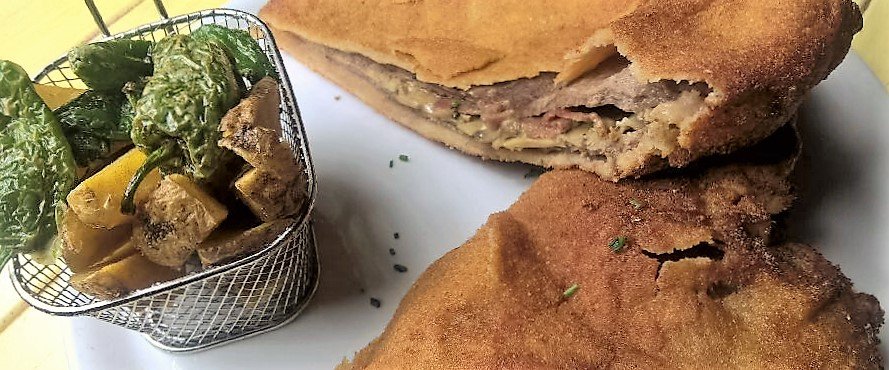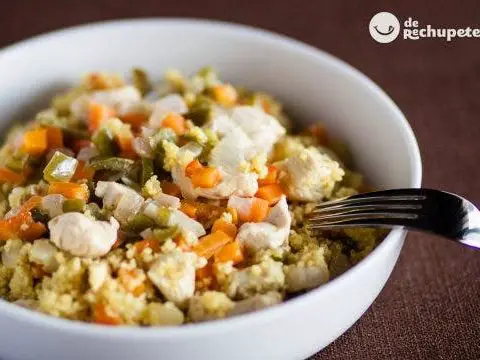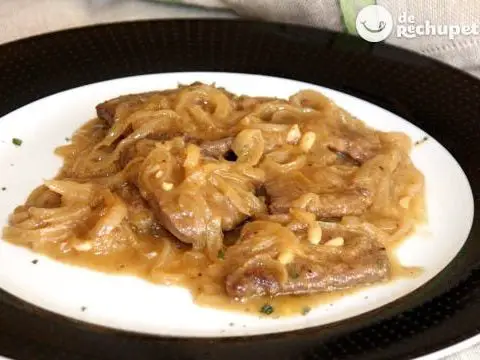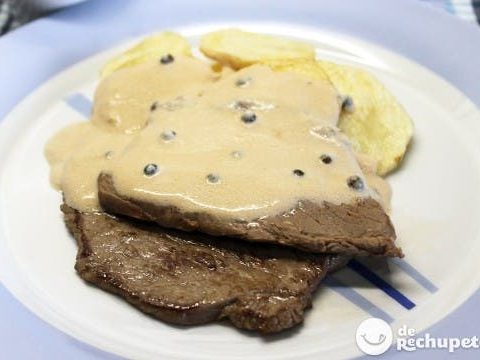
Info.
- Half
- 25 minutes
- For 4 people
- 2.6 € / person
- 305kcal per 100g.
How to prepare an Asturian cachopo .
Lately Asturias has become one of my favorite vacation destinations. Its landscape, gastronomy and people remind me a lot of my land, Galicia.
Many people often say that the Galicians and Asturians are first cousins, it does not amount to much but the north marks, that is true. The beef cachopo that I present to you today, ” Don Cachopo ” for all of you. It is one of the most popular dishes of Asturian cuisine inside and outside its borders.

It is one of those dishes that people talk about, compare and look for the best. Perhaps the debate is at the height of discussions on the best stew , rice pudding , the beans with clams s or frixuelos. In Asturias there is competition for 3 aspects to decide which is the best: the quality, size (which in this case, does matter) and imagination in the fillings .
It is a kind of Saint James to the beast, some also compare it to the cordon bleu . Although the real gangsters are bothered by these comparisons because it is neither one thing nor the other. Although in each house they prepare in one way or another. This recipe for beef cachopo is the most frequent.
The cachopo consists simply of two breaded veal fillets stuffed with cheese and Serrano ham. Once fried, it is crispy on the outside with a tremendously juicy interior.
When we cut it, the essential melted cheese comes out and spreads all over the plate. Normally a single cachopo gives one, two, three and even four people to eat depending on the size, and many restaurants compete to be the one that serves it the largest.
We can find from the classic preparation multiple variants of fish, chicken or pork cubs, stuffed with seafood, jerky, mushrooms, peppers, cheeses, asparagus, … etc. Although my favorite is the one that I present today. I hope you like it and prepare it at home.
Preparation of the meat of the Asturian cachopo
In the ingredients I have said that the fillets must be thin, it is important to be able to fill them better and that later it does not turn out too thick when frying.
If the ones we have are not thin, a good trick is to arrange them between transparent plastic wrap and hit them with the base of a metal saucepan, thus achieving a thinner thickness.
- We prepare our ingredients to make the recipe in an organized and faster way.
- In 3 dishes we have the flour, the breadcrumbs and the 2 beaten eggs. We reserve until the moment of the batter.
- We will use a couple of fillets for each cachopo that are approximately the same size and shape, so that they perfectly match each other.
- Hip steaks are very tender and perfect for this recipe. We will clean them well from the edge ribs so that they do not “shrink” when frying them.
- We are going to work them with a mallet or a stone as I mentioned before, to soften and flatten them.
- We spread a fillet and salt to taste. In one of the halves we place a slice of Serrano ham (or cured meat, the flavor is incredible with it) and on it one of cheese (remember that we can put several types of cheese, the one you like best).
Asturian cachopo breading
- In many places in Asturias they double the content of cheese and ham, but I didn’t want a Jurassic cachopo either. I think one slice of each is more than enough.
- Some people put inside it an open piquillo pepper. The pepper fits divinely with the cachopo and other breads, so inside or outside it will be equally good.
- We close with the other half of the fillet pressing on the edges. This way we will get the meat to bind well and the filling remains inside. We do the same with the remaining fillets.
- We will bread them with the classic batter, passing them through flour, egg and breadcrumbs.
- The flour helps the egg adhere better to the meat. The egg acts as a glue to fix the breadcrumbs. There are those who give a single layer and some prefer to use two.
Cachopo frying and final presentation
- It is best to coat with a single layer so that it is not too thick, so they are lighter and absorb less oil in the frying.
- To get more crispy cubes we can use crisp breadcrumbs that are sold in any supermarket.
- If they are too tight for them to be well closed, you can join them by inserting a toothpick so that they do not open later in the pan.
- We check that the entire surface is well covered. Full batter prevents cheese from releasing inside.
- For frying we are interested in oils with a high smoke point that oxidize (burn) less.
- This depends on the quality of the oil that we use, I recommend an extra soft virgin olive oil, for example an arbequina.
- These oils will allow us to fry at high temperature resulting in a crispy breading after a short process, so the interior will be juicier.
- When we have all the cachopos ready, heat plenty of oil in a frying pan and fry them at medium-high temperature. The oil should not be very hot. This way we avoid that they are very toasted on the outside and raw on the inside.
- We cook them for 2 to 3 minutes on each side, we want to get a crispy golden batter, the meat at its point and the filling with the melted cheese on the ham.
- We remove and reserve on absorbent paper to release excess oil.
- As an accompaniment in most Asturian restaurants you can choose from many types of sauce. For example, a Cabrales sauce, cider sauce, caramelized onion, natural tomato sauce with pepper, grilled vegetables or some caramelized peppers in garlic.
We already have our delicious breaded steaks Asturian style. The famous and traditional cachopos to eat at the weekend and surprise our family or friends.
Be sure to enjoy all the recipes with meat that we have on the blog. You can see all the photos of the step-by-step recipe of the Asturian cachopin .
Tips for a tasty Asturian cachopo
- I recommend serving them with a simple accompaniment that does not detract from the prominence of the cachopo. Some fried potatoes with the cut you like the most, some roasted peppers or a little of your favorite salad. With tomato and basil pieces for example.
- Who invented the cachopo? No one knows, although they say it is a heritage from the French gastronomic culture.
- His invention is attributed to the Asturian chef Fernando Martín, who has already disappeared. The same one that in 1986 obtained a Michelin star in its Trascorrales restaurant in Oviedo.
- It happened in his ovetense restaurant “El Pelayo”, already closed. There they served for the first time a giant cachopo stuffed with asparagus and ham with a frixuelo (crêpe) inside.
- In Asturias the size of the cachopos is usually impressive. So asking for one you can eat several people. For me one of these serves perfectly as a unique dish.
- In Asturias I call them “Don Cachopo” because it imposes a little, but at home you can do it the size you want. I hope you enjoy this recipe, it is very simple and tasty.
Do you like Asturian cuisine?
Is there a ‘fame’? Asturian cuisine is not understood if these recipes.
- If you like the spoon, you can not miss trying its famous bean stew . Its world-famous clams with clams or those spectacular verdinas .
- To open your mouth, you have their pregnant buns or some stuffed onions . The ones I like the most are with bonito, but you also have them with meat.
- To end a gastronomic day that you will not forget. Their desserts, the richest rice pudding you will have ever tasted or Pravia’s tocinillo de cielo .
- And of course a good coffee or infusion must be accompanied by some muscovites . There are a lot of recommendations that you should not miss trying in Asturias or at home, why not?







This Asturian Veal Cachopo recipe is a triumph in my kitchen. Reflecting the unique flavors of Asturias, this dish offers a true culinary delight with thin veal steaks generously filled with cheese and Serrano ham. Known as “Don Cachopo,” this dish has become an essential part of Asturian cuisine.
Cachopo starts with the crispy exterior of thin beef, leading to a juicy interior filled with melted cheese when cut. The debates about whether it is the best are on par with discussions about other famous Asturian dishes. The magic of this dish lies in its size, quality, and the variety of fillings.
While some liken it to Saint James’ feast or a cordon bleu, true enthusiasts argue that Cachopo stands in a league of its own. This step-by-step recipe showcases the art of creating the perfect Cachopo, ensuring a delightful culinary experience.
The breading process, using flour, eggs, and breadcrumbs, sets the stage for a crispy exterior that encapsulates the flavors within. Opting for a single layer ensures a lighter and less oily result, a crucial factor in achieving the ideal texture.
Frying the Cachopos to a golden crispiness requires an artful approach, choosing the right oil with a high smoke point. The result is a perfectly breaded exterior and a juicy interior, creating a harmonious blend of textures and flavors.
Accompanied by a variety of sauces offered in Asturian restaurants, such as Cabrales sauce, apple wine sauce, caramelized onion, tomato with pepper, grilled vegetables, or caramelized peppers in garlic, the Cachopo experience becomes customizable.
While the origin of Cachopo remains a mystery, with some attributing its invention to Asturian chef Fernando Martín, its legacy as a gastronomic heritage is undeniable. Variations with fish, chicken, or pork and a range of fillings are available.
Serve these Asturian Cachopos with a simple side, such as fried potatoes, roasted peppers, or a refreshing salad, allowing the Cachopo to take center stage. Whether enjoyed as a shared dish or individually, Cachopo is a testament to the culinary excellence of Asturias.
If you want to savor the richness of Asturian cuisine at home, give this unique recipe a chance and explore the culinary treasures Asturias has to offer.